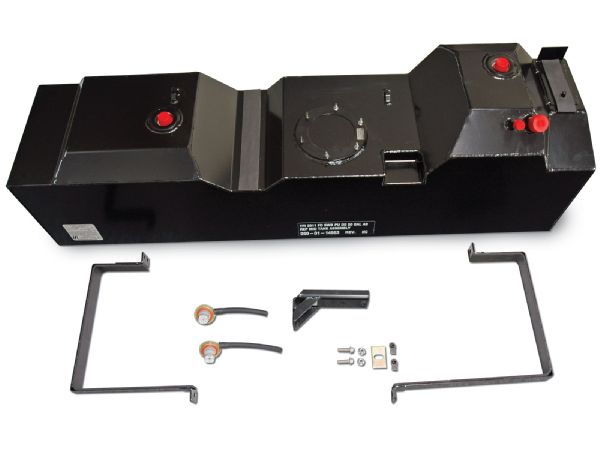
Whether you're four-wheeling in the backcountry, pulling your rockcrawler to the trailhead, or dragging a big toy-hauler to the dunes, you most likely have a fullsize truck. You may also be in the habit of filling up the tank and not thinking about it anymore until you get home. Those days may be over if you're driving a new 2011 Ford diesel shortbed Crew Cab. Why's that?
 Made of 12-gauge steel, the new Transfer Flow 50-gallon replacement tank for the '11 Ford nearly doubles your fuel capacity and comes with all hardware and brackets.
Made of 12-gauge steel, the new Transfer Flow 50-gallon replacement tank for the '11 Ford nearly doubles your fuel capacity and comes with all hardware and brackets.
Thanks to the addition of the Diesel Emission Fluid (DEF) tank just in front of the rear axle, the molded plastic factory fuel tank has been reduced to a petite 26 gallons. Some SUVs have more. Yes, according to some test-drives of recent introductions of the 2011 models, if you drive on a prescribed course at a steady 65 mph with four adults and 1,000 pounds of sand in the bed, never using the A/C and never turning the key off for 80 miles, you might get 20 to 25 mpg. That's great, if that's why you bought an F-250 4x4 Crew Cab. Back in real life, driving around town on 50 to 60 mph roads, you can realistically expect 18 mpg. If you're pulling a big 10,000- to 20,000-pound fifth-wheel toy-haulers, you may be getting an optimistic 9 mpg and you'll be lucky to reach your destination without stopping at least once before that ubiquitous "low fuel" light is staring you in the face.
Leave it to Transfer Flow, one of the largest designers and manufacturers of aftermarket and OEM fuel tanks, to get the most out of the space available. They have just introduced a 50-gallon replacement fuel system, and we took the opportunity to watch one of the first off the assembly line being installed.
Installing the Transfer Flow tank is straightforward. It weighs about 134 pounds, so a proper jack is necessary. Many of the factory bolts and bolt-clips are reused for the new mounting straps. No drilling is done. A single bracket is needed on the outside rear. This is attached to the frame using the existing emergency brake clamp bolt and a factory bolt and clip. Step-by-step instructions with photos are included in the detailed installation manual.
The DEF tank is a totally independent unit. It is not moved nor altered. This DEF process allows the new 6.7L Power Stroke to run leaner at its optimum range in terms of fuel mixture. As the exhaust enters the Diesel Oxidation Catalyst (DOC), oxidized hydrocarbons are turned into carbon dioxide and water. The DOC also increases the exhaust temperature before it flows on into the Selective Catalytic Reduction chamber (SCR). Here the NOx in the exhaust stream is converted into water and inert nitrogen. A separate line runs from the DEF reservoir to the SCR where it atomizes DEF, (an aqueous solution of 67.5 percent water and 32.4 percent pure urea), into the hot exhaust to reduce Nitrous Oxide by as much as 80 percent. Finally, the Diesel Particulate Filter (DPF) traps any remaining soot, which is periodically burned away in the "regeneration" process, at temperatures in excess of 1,100 degrees Fahrenheit. A considerable improvement in economy is a welcome side effect of this complicated process, but there's still no free ride.
This is a big tank, nearly twice the OEM capacity, so we wondered if there would be a clearance problem. The OEM tank shield is at about 14.5 inches from the ground, and the Transfer Flow tank measures 14.75 inches, just a little higher. In normal backroads driving, the differential or transfer case will probably hit first. Cresting a sharp ridge with a long-wheelbase truck, you always need to watch your center pivot point to avoid high-centering.
During our visit, we took an impressive tour of the Transfer Flow factory. Nearly everything including the electrical harnesses is made in house. Tank components and finished products are engineered, bent, formed, and welded. Robots do much of the welding. Aluminum auxiliary tanks and combination toolboxes are all hand-welded. All units must go through a pressurized leak test, fully submerged in a water bath before they are washed, dried, and powdercoated. New designs like this 50-gallon replacement system must go through rigorous testing, including being dropped, full of water, from a 35-foot tower onto a steel plate on a concrete reinforced platform. If it leaks, it goes back to engineering.
The 50-gallon replacement fuel system has a MSRP of $799.50. Installation at the Transfer Flow factory in Chico was $200. Transfer Flow fuel systems are covered by a three-year or 60,000-mile limited warranty.
PhotosView Slideshow










